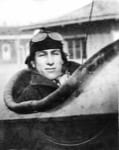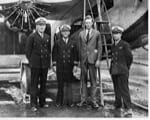
“Air speed record to Los Angeles broken” was a headline in the Oakland (California) Tribune on Jan. 28, 1932. The story reported that a new coastal speed record for tri-motored planes was made on the Oakland-Los Angeles airway when a Transcontinental and Western airplane made the 360-mile hop in 1 hour and 52 minutes.
The craft, a Ford Tri-Motor, piloted by Eddie Bellande and Erwin Lewis, left the Bay Airdrome in Alameda at 10 a.m. and arrived at the Grand Central Air Terminal in Glendale at 11:52 am. Nine passengers were carried on the record-setting flight.
That was just one of the many highlights of Edward A. (Eddie) Bellande’s career in aviation, which spanned nearly 60 years. His career was as diversified and active as the industry itself during those years.
He participated, with other contemporary pilots like Charles Lindbergh, in some of the benchmark flights and activities of this dynamic era. He flew as a test pilot for Lockheed, piloting the first Lockheed Vega. He checked out Wiley Post in the famed “Winnie Mae” and co-piloted Charles Lindbergh on the first TWA transcontinental run in 1929. In addition, he either organized or directed some of the aviation industry’s largest business organizations.
Bellande was born Dec 19, 1897, in Ocean Springs, Miss. In 1915, after completing high school, he went to Buffalo, N.Y., where he spent three months taking flying lessons at the Curtiss Company. He was the youngest member of the graduating class when he received his license (No. 639) from the Aero Club of America.
He then went to the Atlantic Coast Aeroplane Station at Newport News, Va. During World War I, he was at the Georgia School of Technology at Atlanta where he was an instructor in motors and planes at the government ground aviation school. He also served in the United States Marine Corps as a naval reserves aviator from Aug. 18, 1918, until Feb. 24, 1919, ending his service as a flight instructor at the Pensacola Naval Air Station.
Early in 1921, he left for Southern California to work for one of the large movie companies as an aviator. While working in Hollywood, he flew for movie studios headed by Jack L. Warner and Darryl F. Zanuck. Besides being a movie stunt pilot, he kept busy as a flight instructor and barnstormer.
Shortly after arriving in Los Angeles he flew for DeMille’s Mercury Aviation Co. at its Wilshire Boulevard Airport. From 1922 to 1927 he was a freelance pilot flying for motion pictures, skywriting, crop dusting and barnstorming.

During 1927-1929 he was in great demand as test pilot by airplane manufacturers. He made the test flights on most of the Lockheed airplanes, including the first “Vega” and the “Golden Eagle.” He also did all test flights on Northrop’s first flying wing. Later Bellande would join Northrop as a sales pilot and corporate director.
During this same time, he joined Maddux Airlines flying Ford Tri-Motors. He continued flying for the fledgling airline through the mergers of Maddux and Transcontinental Air Transport (TAT) and the later Transcontinental and Western Air merger (which would eventually become Trans World Airlines or TWA).
By mid-year 1929 TAT commenced a 48-hour combination rail and air service across the United States between New York and Los Angeles. The first west-to-east flight was made July 8, 1929, aboard the Ford Tri-Motor, “City of Los Angeles,” piloted by Lindbergh and Bellande. The first east-bound leg was from Glendale, Calif., to Clovis, N. M. The next day Bellande and Lindbergh picked up passengers for the last leg of the transcontinental trip to Los Angeles. Among the passengers on this trip was Amelia Earhart, who had been hired by TAT to help market the service.

The advent of this service so captured the public imagination that six weeks before the service commenced, TAT reported receiving more than 1,000 applications for tickets for the first trip.
One of the most remarkable events in Bellande’s career was the result of an in-flight fire. On Feb. 10, 1933, on a night flight in a TWA Ford Tri-Motor from San Francisco to Los Angeles via Fresno and Bakersfield, the airplane caught fire about 10 miles out from Bakersfield. Apparently the floor heater, which operated from an exhaust stack on the nose engine, caught fire. Bellande managed to make it to the airport, land and safely evacuate the passengers. The fuselage of the plane was completely burned through. A close call, used by some to tout the benefits of “all-metal” construction.
Because of his heroic actions during the emergency, Bellande was one of seven mail pilots who earned the Air Mail Flyers Medal of Honor from President Roosevelt.
Bellande flew for TWA another 10 years. At the time of his retirement in January 1943, he was the Number 2 pilot in seniority. He had logged more than 23,000 hours and flew an impressive 3.1 million miles without injury to passengers or mail cargo.
He joined the Garrett Corp. in 1943 as an assistant to the president. He was elected to the board of directors in 1948, and named chairman of the board in July 1963.
The early days of aviation in California were rich in flying excitement against a background of aircraft and airline development. Edward Bellande was an integral part of many of these developments.
Dennis Parks is Curator Emeritus of Seattle’s Museum of Flight. He can be reached at [email protected].
